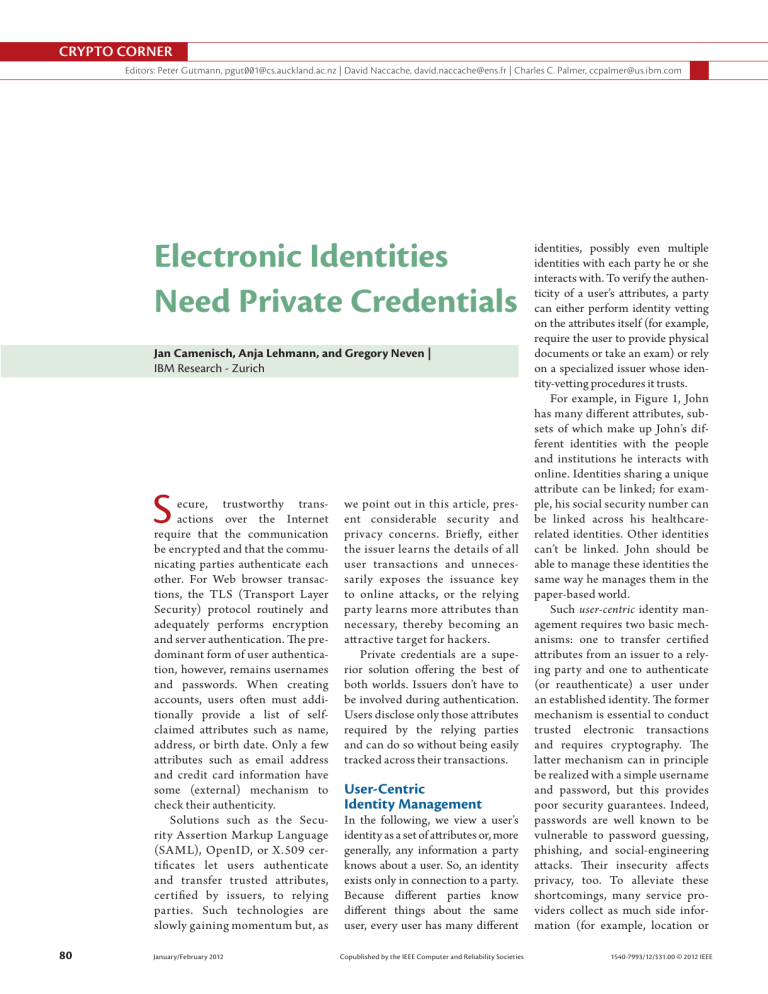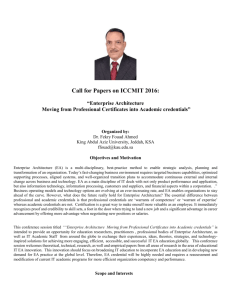Electronic Identities Need Private Credentials
advertisement

CRYPTO CORNER Editors: Peter Gutmann, pgut001@cs.auckland.ac.nz | David Naccache, david.naccache@ens.fr | Charles C. Palmer, ccpalmer@us.ibm.com Electronic Identities Need Private Credentials Jan Camenisch, Anja Lehmann, and Gregory Neven | IBM Research - Zurich S ecure, trustworthy transactions over the Internet require that the communication be encrypted and that the communicating parties authenticate each other. For Web browser transactions, the TLS (Transport Layer Security) protocol routinely and adequately performs encryption and server authentication. The predominant form of user authentication, however, remains usernames and passwords. When creating accounts, users often must additionally provide a list of selfclaimed attributes such as name, address, or birth date. Only a few attributes such as email address and credit card information have some (external) mechanism to check their authenticity. Solutions such as the Security Assertion Markup Language (SAML), OpenID, or X.509 certificates let users authenticate and transfer trusted attributes, certified by issuers, to relying parties. Such technologies are slowly gaining momentum but, as 80 January/February 2012 we point out in this article, present considerable security and privacy concerns. Briefly, either the issuer learns the details of all user transactions and unnecessarily exposes the issuance key to online attacks, or the relying party learns more attributes than necessary, thereby becoming an attractive target for hackers. Private credentials are a superior solution offering the best of both worlds. Issuers don’t have to be involved during authentication. Users disclose only those attributes required by the relying parties and can do so without being easily tracked across their transactions. User-Centric Identity Management In the following, we view a user’s identity as a set of attributes or, more generally, any information a party knows about a user. So, an identity exists only in connection to a party. Because different parties know different things about the same user, every user has many different Copublished by the IEEE Computer and Reliability Societies identities, possibly even multiple identities with each party he or she interacts with. To verify the authenticity of a user’s attributes, a party can either perform identity vetting on the attributes itself (for example, require the user to provide physical documents or take an exam) or rely on a specialized issuer whose identity-vetting procedures it trusts. For example, in Figure 1, John has many different attributes, subsets of which make up John’s different identities with the people and institutions he interacts with online. Identities sharing a unique attribute can be linked; for example, his social security number can be linked across his healthcarerelated identities. Other identities can’t be linked. John should be able to manage these identities the same way he manages them in the paper-based world. Such user-centric identity management requires two basic mechanisms: one to transfer certified attributes from an issuer to a relying party and one to authenticate (or reauthenticate) a user under an established identity. The former mechanism is essential to conduct trusted electronic transactions and requires cryptography. The latter mechanism can in principle be realized with a simple username and password, but this provides poor security guarantees. Indeed, passwords are well known to be vulnerable to password guessing, phishing, and social-engineering attacks. Their insecurity affects privacy, too. To alleviate these shortcomings, many service providers collect as much side information (for example, location or 1540-7993/12/$31.00 © 2012 IEEE transaction history) about users as they can and analyze that data to detect suspicious behavior and potential breaches. So, a stronger cryptographic mechanism for authentication involving publickey cryptography seems advisable. In our paper-based world, attribute transfer and authentication are often folded into one mechanism. For instance, a driver’s license transfers the attribute “I’m allowed to drive a car” from the issuer to any relying party and, via the photo on it, provides an authentication mechanism. When realizing attribute transfer and authentication for the digital world, mimicking the paperbased solutions, as often happens, isn’t enough. Instead, you must consider the very different environment: digital data is easily copied and virtually impossible to control once released. So, any digital realization must follow the principle of data minimization. When a user transfers an attribute from an issuer to a relying party, neither party should be able to learn any information that the transferred attribute hasn’t already revealed, even if the parties collaborated. Of course, an identity management system adhering to these principles doesn’t eliminate all the digital world’s dangers. Communication and stored information should always be encrypted. Sensitive data should be accompanied with usage policies defining how to treat it, who can use it, for what purpose it’s to be used, and when to delete it. We don’t elaborate on these issues here; we concentrate on the identity management mechanisms. Existing Solutions to Transfer Attributes Roughly, existing solutions to transfer certified user attributes from an issuer to a relying party are either offline or online. Offline solutions involve the issuer only www.computer.org/security MyEmployer.com OnLineShop.com Foreign language Education Salary Capabilities Address Name Income Etc. Denomination Credit cards Tax status Account Marital status number Birth date Salary Hobbies Insurance Nickname Phone number Health status Likes and dislikes Blood group Gov.org SportsClub.com Complete identity of John Identity of John with some party HealthInsurancePro.com Figure 1. John’s multiple online identities. Private credentials can help him manage those identities the same way he manages his identities in the paper-based world. at the time of issuance. Online solutions also actively involve the issuer during attribute transfer. The most prominent offline solution is X.509 v3 certificates with attribute extensions. Here, the issuer or certificate authority (CA) signs the user’s public key together with his or her attributes and includes the signature in the certificate. The way X.509 credentials are constructed forces the user to reveal all of the attributes in the certificate when transferring an attribute. Moreover, the user’s public key acts as a unique identifier that follows the user across all of his or her online transactions. In online solutions, the user first authenticates directly to the issuer. The issuer then creates a verifiable token for the specific set of attributes required by the relying party. Popular examples following this approach include SAML and WS-Federation, as well as the more lightweight OpenID. The advantage of this approach is that only the required attributes are revealed. However, the issuer learns which user authenticates to which relying party at which time. Although some protocols can optionally hide the user’s identity from the relying party and hide the relying party’s identity from the issuer, this doesn’t help when relying parties and issuers compare their transaction logs. In addition, with online solutions, the issuance key must be on a system that’s permanently connected to the Internet. This considerably increases the issuer’s vulnerability to intruders, thus endangering the entire system’s security. Private Credentials Private credentials are similar to the offline approach in terms of the overall functionality and provided security guarantees, while letting users control and separate their different identities.1–3 81 CRYPTO CORNER How They Work by which the user is known to the Alice’s electronic identity card is Similarly to the approach with issuer. The user then transforms a private credential containing as X.509 certificates, each user gener- the credential so that it contains attributes her name, birth date, and ates a secret key and correspond- only those attributes the user wants address. Further suppose Alice’s ing public key. The credential is to transfer and so that it’s valid for hometown provides an online a signature by the issuer on the the public key by which the user is feedback system for its residents. user’s attributes and public key. To known to the relying party. Now, by transforming her identity transfer attributes, the user signs a As you can see, the high-level credential into one that contains challenge message using his or her principles of private credentials merely the ZIP code, she can prosecret key and sends the signature and traditional certificates are vide her feedback anonymously, along with the issuer-signed cre- largely the same. The sole differ- while her hometown is ensured dential to the relying party. The ence is that the two approaches she’s a valid resident. user can authenticate under a pub- use different cryptographic algolic key by signing a challenge mes- rithms to generate public keys and Further Features sage using the secret key. sign certificates and messages. So, Private credentials offer all the feaHowever, private credentials you can use private credentials in tures of a traditional public-key have two unique properties. First, any situation in which you can use infrastructure. Moreover, they the user can generate many pub- traditional certificates, simply by offer many features that traditional lic keys from the single secret key. replacing the algorithms. Private certificates don’t. For instance, These public keys instead of revealing attrican’t be linked. That bute values, users can Private credentials can form the is, given two public choose to merely reveal keys, you can’t tell that some predicate over foundation of electronic networks’ whether they belong the attributes holds. identity layer, providing the same or to the same user or In the previous identwo different users. tity card example, Alice even better security for the relying Second, a crecould transform her creparties while respecting user privacy. dential issued to one dential into one stating public key can be solely that her birthday is (repeatedly) transbefore 1994. formed into a credential that’s valid credentials provide the same level of Private credentials also let on another public key of the same security but also guarantee privacy. users provide attributes in verifiuser. Moreover, the transformed ably encrypted form to the relycredential can contain a selected Usage Scenarios ing party, so that they’re available subset of the attributes in the origi- Consider an online journal to only to a dedicated trusted third nal credential. Transformed cre- which users subscribe to access party. This mechanism allows, for dentials are unlinkable. That is, for articles. When subscribing, the instance, investigation of abuse of two transformed credentials with user generates a fresh public key the provided anonymity. disjoint sets of revealed attributes, from the secret key and obtains Assume Alice’s hometown you can’t tell whether they origi- from the publisher a private cre- wants to conduct an anonymous nated from the same credential or dential on this public key. When poll, allowing each resident to pardifferent credentials. All creden- the user later wants to access an ticipate only once. To enforce the tials, both the transformed and article, he or she generates another latter, the hometown can ask its original ones, still verify correctly fresh public key, transforms his or residents to enable a mode of crewith regard to the issuer’s verifica- her credential, and sends both to dential transformation that lets tion key. the journal website. As with tradi- it detect repeated use of the same These properties are crucial tional certificates, the journal has credential. Of course, this mode to let users properly manage their the strong cryptographic guar- preserves the anonymity and identities. They can generate one antee that no unregistered users unlinkability for honest users. public key for each identity. To can download articles. However, transport attributes from an issuer users can rest assured that no one to a relying party, the user first is tracking or profiling their readrivate credentials can form obtains a credential including ing behavior. the foundation of electronic those attributes for the public key As another example, suppose networks’ identity layer, providing P 82 IEEE Security & Privacy January/February 2012 the same or even better security for the relying parties while respecting user privacy. The cryptographic literature contains a fair number of proposals on how to implement private credentials based on different cryptographic assumptions. In fact, the research community around privacyprotecting mechanisms is active and growing. Nevertheless, private credentials are ready for deployment in practice. Microsoft’s U-Prove4 and IBM’s Identity Mixer5 are two implementations of private credentials that are publicly available and have been demonstrated to be viable. Currently, both are being integrated and used for two pilots in the EU-funded project ABC4Trust (https://abc4 trust.eu). References 1. D. Chaum, “Untraceable Electronic Mail, Return Addresses, and Digital Pseudonyms,” Comm. ACM, vol. 24, no. 2, 1981, pp. 84–88. 2. S. Brands, “Rethinking Public Key Infrastructure and Digital Certificates—Building in Privacy,” PhD thesis, Eindhoven Inst. of Technology, 1999. 3. J. Camenisch and A. Lysyanskaya, “Efficient Non-transferable Anonymous Multi-show Credential System with Optional Anonymity Revocation,” Advances in Cryptology—Eurocrypt 2001, LNCS 2045, Springer, 2001, pp. 93–118. 4. Microsoft U-Prove Community Technology Preview R2, Microsoft, 2011; https://connect. microsoft. com/site1188. 5. “Identity Mixer,” blog; http://ide mix.wordpress.com. Jan Camenisch is a research staff member at IBM Research ­Zurich. Contact him at jca@ zurich.ibm.com. Anja Lehmann is a postdoc at IBM Research - Zurich. Contact her at anj@zurich.ibm.com. Gregory Neven is a research staff member at IBM Research ­Zurich. Contact him at nev@ zurich.ibm.com. Selected CS articles and columns are also available for free at http://ComputingNow.computer.org. NEW TITLE FROM 15% Off The IBM Century Edited by Jeffrey R. Yost Bringing together memoirs of key IBM engineers and managers of the past 100 years, this unique volume details IBM’s entrance into computing and the transformative IBM hardware and software that changed the world. Features include an IBM timeline, the most comprehensive IBM annotated bibliography to date, and a new introductory essay. TO ORDER ISBN 978-0-7695-4611-7 • November 2011 • 292 pages Paperback • $29.95 • An IEEE Computer Society Press Publication www.computer.org/security Online Orders http://bit.ly/x4E0Er Enter code DZWE5FVE for 15% off!* Also available on http://amazon.com * Discount code only valid on createspace.com 83





